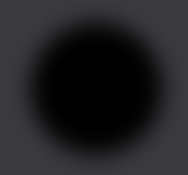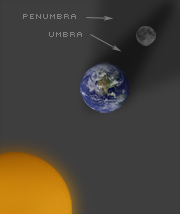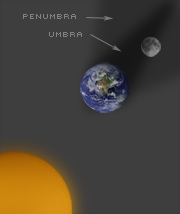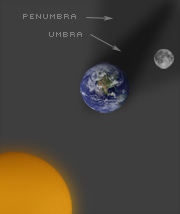


Lunar Eclipses:
When is the next Lunar Eclipse?
The next Lunar Eclipse will be a Total Eclipse and occur on Sept 27-28, 2015. It will be visible in Asia, Australia, Pacific and the Americas with a duration of 3h 20m.
Click here for Viewing Times >
2015 Lunar Eclipses |
Apr 4, 2015 |
Total Eclipse - Will be visible in Asia, Australia, Pacific and the Americas with a duration of 3h 29m. Of this time the eclipse will be total for 5m. |
Sept 28, 2015 |
Total Eclipse - Will be visible in Asia, Australia, Pacific and the Americas with a duration of 3h 20m. Of this time the eclipse will be total for 1h 12m. |
2016 Lunar Eclipses |
Mar 23, 2016 |
Penumbral Eclipse - Will be visible in Asia, Australia, Pacific and the Western Americas |
Sept 16, |
Penumbral - Will be visible in Europe, Africa, Asia and West Pacific. |
2017 Lunar Eclipses |
Feb 11, 2017 |
Penumbral Eclipse - Will be visible in Europe, Africa, Asia and Americas |
Aug 7, 2017 |
Partial - Will be visible in Australia, Europe, Africa and Asia |
What is a Lunar Eclipse
A Lunar Eclipse occurs when the Moon passes through the shadow of the Earth. For this to happen the Sun, Earth, and Moon must be closely aligned with the Moon and the Moon located furthest from the Sun. There are a few different types of Lunar Eclipse that are determined by where the moon is in relationship to the shadow of the Earth.
This Lunar Eclipse Calendar is a listing of all Lunar Eclipses from 2014 to 2015. The cart shows the date of each eclipse as well as the duration and type of Eclipse. The Map shows the general location that the Eclipse will be visible in.
Total Eclipse
A Total Eclipse occurs when the moon is completely blocked from the sun. When the Moon is in this location it is in the Umbra region of the Earth's Shadow. The Umbra is darkest region of the Earth's shadow and recieves little or no solar radiation.
While other types of Lunar Eclipses can be viewed in wide regions of the earth the part of the eclipse that is "Total" is viewable is a much smaller region. The same can be said for the duration of the Eclipse. An Ecplise can last around 3 hours but the time that it is full is generaly around an hour or less.

Partial Eclipse
A Partial Eclipse occurs when the moon partialy enters the Umbra shadow of the Earth but is no completely blocked from the sun. When the Moon is in this location it is partialy in the Penumbra and partialy in the Umbra on the Earths Shadow.
The effect that this type of Eclipse has when located on Earth is that the Moon is partialy shaded on one side. The shaded side of the moon is the darkest part of the earths shadow(Umbra).
Partial Eclipse are generally visiable in a wide area of the earth.

Penumbra Eclipse
A Penumbra Eclipse occurs when the moon only enters the Penumbra area of the Earth's shadow. The Penumbra is a region of the shadow that is not completely obsured from the rays of the sun. This lighter shadow is a result of the relative size of the Sun to the Earth.
This type of Eclipse causes the moon to only darken slightly when viewed from earth and is one of the less dramatic Lunar eclipse.






